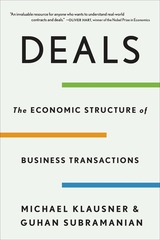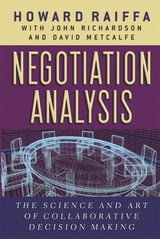
“An invaluable resource for anyone who wants to understand real-world contracts and deals.” —Oliver Hart, winner of the Nobel Prize in Economics
Drawing on real-life cases from a wide range of industries, two acclaimed experts offer a sophisticated but accessible guide to business deals, designed to maximize value for your side.
Business transactions take widely varying forms, from corporate mergers to patent licenses to the signing of an all-star quarterback. Yet every deal shares the same goal, or at least should: to maximize joint value and distribute that value among the parties. Building on decades of experience advising on business deals, Michael Klausner and Guhan Subramanian show how to accomplish this goal through the design of incentives, mitigation of information asymmetries, and attentiveness to parties’ rights and obligations.
Deals captures the range of real-life transactional complexities with case studies covering Microsoft’s acquisition of LinkedIn, a contract dispute between Disney and actor Scarlett Johansson, litigation surrounding LVMH’s pandemic-disrupted acquisition of Tiffany, NBC/Viacom’s negotiation with Paramount over the final three seasons of Frasier, and many more. Klausner and Subramanian concisely establish the framework of negotiation and the economic concepts underlying value maximization. They show how to tackle challenges such as moral hazard and opportunistic behavior and lay out responses to common risks associated with long-term contracts.
Unique in applying economic theory to actual transactions, Deals is an indispensable resource for students and professionals across the business and legal worlds.



This masterly book substantially extends Howard Raiffa's earlier classic, The Art and Science of Negotiation. It does so by incorporating three additional supporting strands of inquiry: individual decision analysis, judgmental decision making, and game theory. Each strand is introduced and used in analyzing negotiations.
The book starts by considering how analytically minded parties can generate joint gains and distribute them equitably by negotiating with full, open, truthful exchanges. The book then examines models that disengage step by step from that ideal. It also shows how a neutral outsider (intervenor) can help all negotiators by providing joint, neutral analysis of their problem.
Although analytical in its approach--building from simple hypothetical examples--the book can be understood by those with only a high school background in mathematics. It therefore will have a broad relevance for both the theory and practice of negotiation analysis as it is applied to disputes that range from those between family members, business partners, and business competitors to those involving labor and management, environmentalists and developers, and nations.
READERS
Browse our collection.
PUBLISHERS
See BiblioVault's publisher services.
STUDENT SERVICES
Files for college accessibility offices.
UChicago Accessibility Resources
home | accessibility | search | about | contact us
BiblioVault ® 2001 - 2025
The University of Chicago Press









